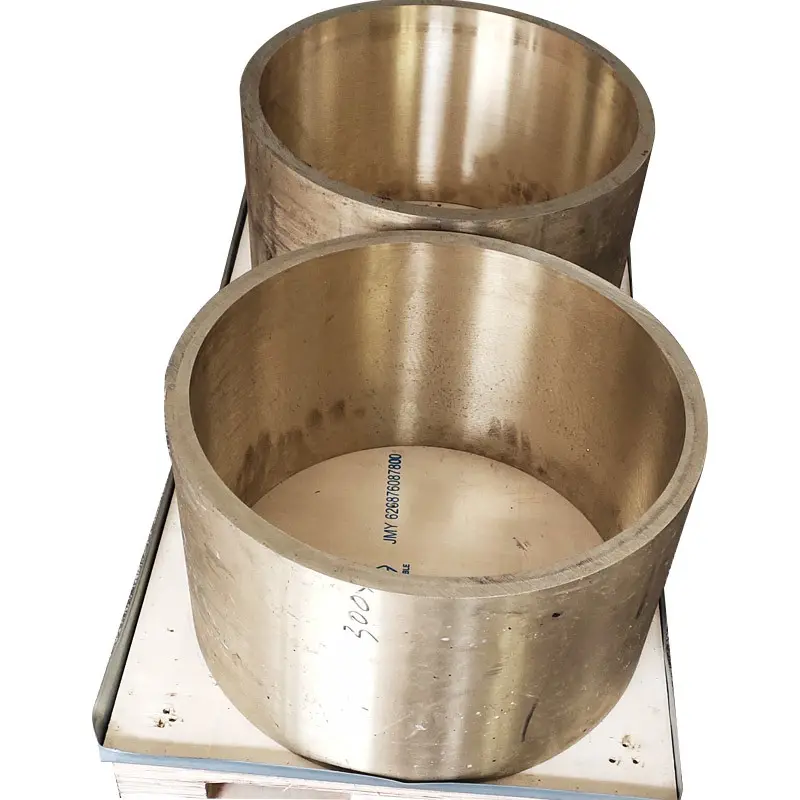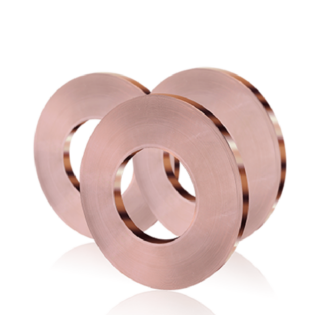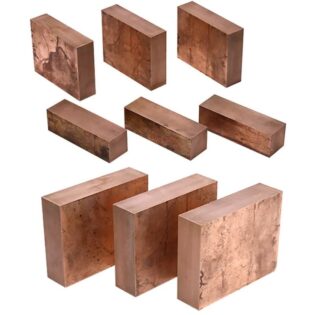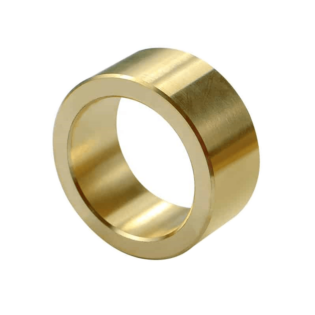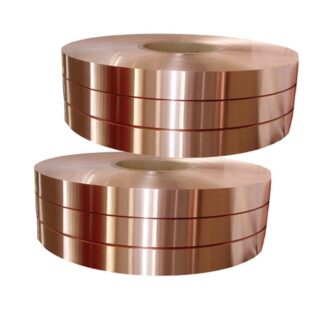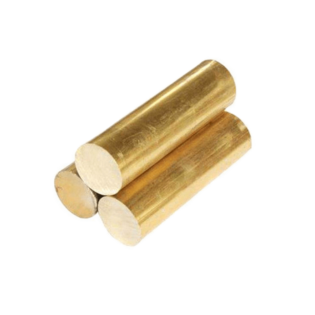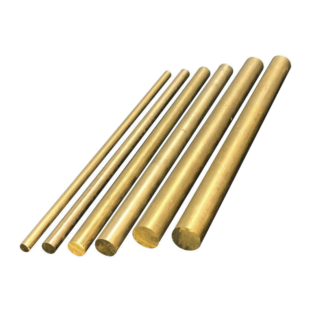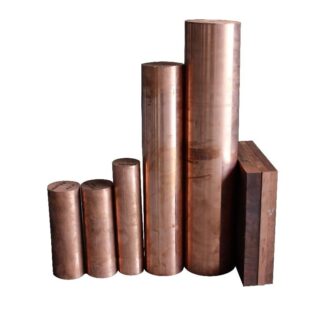C95400 Descrição do produto: Bronze de alumínio
C95400 Níquel-Alumínio Bronze é uma liga de cobre de alto desempenho conhecida por suas propriedades mecânicas excepcionais e resistência superior à corrosão. Este material versátil é amplamente utilizado em aplicações marítimas, industriais e aeroespaciais. Sua composição única, misturando cobre com alumínio, níquel, ferro e manganês, contribui para seu excelente desempenho em ambientes desafiadores.
Os principais recursos do C95400 incluem:
- Excelente resistência à corrosão, especialmente em água do mar
- Alta resistência e durabilidade
- Boa resistência ao desgaste
- Propriedades anti-faíscas
- Resistência à cavitação
- Capacidade de manter a resistência em temperaturas elevadas
Essas características tornam o C95400 a escolha ideal para componentes críticos em diversos setores, desde a construção naval até a engenharia aeroespacial.
Introdução do produto:
C95400 Níquel-Alumínio Bronze é uma liga de cobre de alto desempenho que combina excelentes propriedades mecânicas com resistência superior à corrosão. Este material versátil é amplamente utilizado em diversas indústrias, particularmente em aplicações marítimas, industriais e aeroespaciais. Sua composição única de cobre, alumínio, níquel, ferro e manganês contribui para seu desempenho excepcional em ambientes exigentes.
Composição química:
A composição química do C95400 é cuidadosamente balanceada para atingir as propriedades desejáveis:
Tabela 1: Composição Química do C95400 (%)
| Elemento | Percentagem |
|---|---|
| Cu | 83,00 minutos |
| Fe | 3h00-5h00 |
| Em* | 1,50 |
| Al | 10h00-11h50 |
| Mn | 0.50 |
*Valor Ni inclui Co.
Nota: Cu + soma dos elementos nomeados, 99,5% min. Salvo indicação em contrário, valores únicos representam máximos.
Propriedades mecânicas:
O C95400 apresenta fortes propriedades mecânicas, tornando-o adequado para uma ampla gama de aplicações:
Tabela 2: Propriedades Mecânicas do C95400
| Propriedade | Costumeiro dos EUA | Métrica |
|---|---|---|
| Resistência à tração (min) | 85 ksi | 586 MPa |
| Força de rendimento (min) | 32 ksi | 221MPa |
| Alongamento (min) | 12% | 12% |
| Dureza Brinell (carga de 3000 kg, típica) | 170 BHN | 170 BHN |
Desempenho em diferentes temperaturas:
O C95400 mantém sua resistência em temperaturas elevadas, tornando-o adequado para aplicações em altas temperaturas:
Tabela 3: Desempenho em Diferentes Temperaturas
| Temperatura | Resistência à tracção | Força de rendimento |
|---|---|---|
| 20°C (68°F) | 586 MPa (85 ksi) | 221 MPa (32 ksi) |
| 200°C (392°F) | 510 MPa (74 ksi) | 200 MPa (29 ksi) |
| 400°C (752°F) | 420 MPa (61 ksi) | 180 MPa (26 ksi) |
Nota: Os valores são aproximados e podem variar com base em tratamentos térmicos e processos de fabricação específicos.
Aplicações da indústria:
A versatilidade do C95400 o torna adequado para uma ampla gama de aplicações em vários setores:
Tabela 4: Aplicações Industriais do C95400
| Indústria | Formulários |
|---|---|
| Automotivo | Pistolas de solda |
| Fixadores | Parafusos de fixação grandes, porcas |
| Industrial | Segmentos de rolamentos, buchas, engrenagens, braçadeiras de alta resistência, |
| peças de trem de pouso, peças de máquinas, lingueta, ganchos de decapagem, | |
| blocos de pressão, peças de bombas, componentes de válvulas | |
| Marinho | Coberturas para ferragens marítimas, construção naval |
| Artilharia | Acessórios governamentais |
| Aeroespacial | Componentes do trem de pouso, buchas |
| Oil & Gas | Corpos de válvulas, componentes de bombas |
Disponibilidade de formato e tamanho:
O C95400 está disponível em vários formatos e tamanhos para atender a diferentes requisitos de fabricação:
Tabela 5: Disponibilidade de formato e tamanho
| Forma | Faixa de tamanho |
|---|---|
| Sólidos | 1/2 ″ a 10 ″ diâmetro externo |
| Tubos | 1 1/8 ″ a 12 ″ diâmetro externo (Consulte a fábrica para espessura da parede) |
| Retângulos | Até 15″ |
| Comprimentos padrão | 144″ |
| Outros formulários | Semi-acabado, estoque de moagem, formatos quase-líquidos, |
| ânodo, barra, tarugo/flor, quadrados, | |
| hexágono, placa, perfil ou formato estrutural, | |
| barra plana/retangular |
Padrões de produção:
C95400 está em conformidade com vários padrões da indústria:
Tabela 6: Padrões de Produção
| Tipo padrão | Designação |
|---|---|
| CDA | C95400 |
| ASTM | B505, B505M |
| SAE | J461, J462 |
| Federal | QQ-C-390, G5; QQ-B-671, Classe 3 |
| Militares | MIL-B-16033, Classe 3 |
| Outro | Bronze de alumínio 9C |
Padrões e notas correspondentes em diferentes países:
C95400 possui classificações equivalentes ou semelhantes em vários padrões internacionais:
Tabela 7: Padrões e Graus Correspondentes em Diferentes Países
| País | Padrão/Grau |
|---|---|
| EUA | C95400 (EUA) |
| Reino Unido | AB2 (BS) |
| Alemanha | CuAl10Ni5Fe4 (DIN) |
| Japão | CAC703 (HE) |
| Internacional | ISO 428-2:2009 CuAl10Ni5Fe4 |
Soldagem, processamento e tratamento térmico:
O C95400 pode ser processado usando vários métodos, cada um com suas próprias características:
Tabela 8: Soldagem, Processamento e Tratamento Térmico
| Processo | Recomendações e características |
|---|---|
| De solda | Boa adequação |
| Brasagem | Boa adequação |
| Soldagem Oxiacetileno | Não recomendado |
| Soldagem a arco com proteção a gás | Boa adequação |
| Soldagem a arco de metal revestido | Boa adequação |
| Usinagem | Classificação de usinabilidade: 60 |
| Use ferramentas afiadas e velocidades de corte moderadas | |
| Polimento | Pode alcançar alto brilho com técnicas adequadas |
| Tratamento térmico | Recozimento em solução a 900-950°C, têmpera em água |
| Processamento a frio | Possibilidade de trabalho a frio limitado, ocorre endurecimento por deformação |
Vantagens e desvantagens:
O C95400 oferece diversas vantagens, mas também possui algumas limitações:
Tabela 9: Vantagens e Desvantagens do C95400
| Vantagens | Desvantagens |
|---|---|
| Excelente resistência à corrosão | Custo mais alto que bronzes padrão |
| Boa resistência ao desgaste | Disponibilidade limitada |
| Força elevada | Mais difícil de usinar |
| Propriedades anti-faíscas | Mais pesado que ligas de alumínio |
| Boa resistência à cavitação | Menor condutividade térmica que o cobre puro |
| Excelente resistência à fadiga | Potencial para fissuração por corrosão sob tensão |
| Boa resistência a altas temperaturas | Suscetível à lixiviação seletiva em alguns ambientes |
Produtos semelhantes e comparação:
Para entender melhor a posição do C95400 entre ligas similares, aqui está uma comparação:
Tabela 10: Produtos Similares e Comparação
| Liga | Cu% | Al% | em % | Fe% | Mn% | Resistência à tração (MPa) | Força de rendimento (MPa) |
|---|---|---|---|---|---|---|---|
| C95400 | 83 minutos | 10-11,5 | 1,5 máx. | 3-5 | 00,5 máx. | 586 minutos | 221 minutos |
| C95500 | 78-82 | 10-11,5 | 3-5,5 | 3-5,5 | 3,5 máx. | 690 minutos | 280 minutos |
| C95800 | 79-82 | 8,5-9,5 | 4-5 | 3,5-4,5 | 1,5 máx. | 585 minutos | 240 minutos |
| C95700 | 71-79 | 10-12 | 4,5-6 | 4-5,5 | 1,5 máx. | 620 minutos | 275 minutos |
Propriedades físicas:
Compreender as propriedades físicas do C95400 é crucial para sua aplicação em diversos ambientes:
Tabela 11: Propriedades Físicas do C95400
| Propriedade | Costumeiro dos EUA | Métrica |
|---|---|---|
| Ponto de Fusão – Líquido | 1.900°F | 1038ºC |
| Ponto de Fusão – Sólido | 1.880°F | 1027°C |
| Densidade | 00,269 lb/pol³ a 68 °F | 7,45 g/cm³ a 20°C |
| Gravidade Específica | 7h45 | 7h45 |
| Condutividade elétrica | 13% SIGC | 00,075 MegaSiemens/cm a 20°C |
| Condutividade térmica | 33,9 Btu/pé quadrado/pé hora/°F a 68 °F | 58,7 W/m a 20 °C |
| Coeficiente de Expansão Térmica | 9 · 10⁻⁶ por °F (68-572 °F) | 15,5 · 10⁻⁶ por °C (20-300 °C) |
| Capacidade Específica de Calor | 00,1 Btu/lb/°F a 68°F | 419 J/kg a 20°C |
| Módulo de elasticidade em tensão | 15.500 ksi | 107.000 MPa |
| Permeabilidade Magnética (conforme fundido) | 1,27 | 1,27 |
| Permeabilidade Magnética (têmpera TQ 50) | 1.2 | 1.2 |
Essas propriedades físicas contribuem para o desempenho do C95400 em diversas aplicações. O alto ponto de fusão permite o uso em ambientes de temperatura elevada, enquanto a densidade relativamente alta proporciona boa resistência ao desgaste e resistência. A condutividade térmica e elétrica moderada o torna adequado para aplicações onde a dissipação de calor é importante, mas não crítica.
Propriedades de fabricação:
Compreender as propriedades de fabricação do C95400 é crucial para fabricantes e engenheiros:
Tabela 12: Propriedades de Fabricação do C95400
| Método de Fabricação | Adequação/Características |
|---|---|
| De solda | Bom |
| Brasagem | Bom |
| Soldagem Oxiacetileno | Não recomendado |
| Soldagem a arco com proteção a gás | Bom |
| Soldagem a arco de metal revestido | Bom |
| Usinagem | Moderado (classificação de usinabilidade: 60) |
| Forjamento | Bom (temperatura típica de forjamento: 1600-1800°F / 870-980°C) |
| Trabalho a Quente | Bom (temperatura típica de trabalho a quente: 1300-1600°F / 700-870°C) |
| Trabalho a frio | Limitado (o trabalho endurece rapidamente) |
| Tratamento térmico | Responsivo ao tratamento térmico para melhoria de propriedade |
O C95400 apresenta boa soldabilidade usando técnicas de soldagem por arco com proteção de gás e soldagem por arco de metal revestido. Porém, a soldagem oxiacetileno não é recomendada devido ao risco de alteração da composição da liga. A usinabilidade moderada do material (classificação de 60) sugere que, embora possa ser usinado, pode exigir mais esforço e ferramentas especializadas em comparação com ligas mais facilmente usináveis.
Conformidade e Regulamentos:
C95400 Níquel-Alumínio Bronze está em conformidade com vários regulamentos importantes, especialmente aqueles relacionados a sistemas de água e segurança ambiental:
Tabela 13: Conformidade do C95400
| Legislação/Regulamento | Status de conformidade |
|---|---|
| Lei Federal de Água Potável Segura (SDWA) | Compatível |
| S. 3874 Lei Federal de Redução de Chumbo em Água Potável | Compatível |
| Califórnia AB1953 | Compatível |
| Lei de Vermont 193 | Compatível |
| RoHS (Restrição de Substâncias Perigosas) | Compatível |
| REACH (Registro, Avaliação, Autorização e Restrição de Produtos Químicos) | Compatível |
Esta conformidade garante que o C95400 possa ser utilizado numa ampla gama de aplicações, incluindo aquelas que envolvem contacto com água potável, sem representar riscos para a saúde ou para o ambiente.
Resistência à corrosão:
Uma das vantagens mais significativas do C95400 é a sua excelente resistência à corrosão em vários ambientes:
Tabela 14: Resistência à corrosão do C95400 em vários ambientes
| Ambiente | Classificação de resistência à corrosão |
|---|---|
| Água do mar | Excelente |
| Água doce | Excelente |
| Água Salobra | Excelente |
| Ácido Sulfúrico (diluído) | Bom |
| Ácido clorídrico (diluído) | Moderado |
| Ácido Nítrico (diluído) | Pobre |
| Soluções Alcalinas | Excelente |
| Atmosferas Industriais | Excelente |
| Atmosferas Marinhas | Excelente |
A excelente resistência à corrosão na água do mar e em atmosferas marinhas torna o C95400 uma escolha ideal para ferragens marítimas, hélices e componentes de construção naval. A sua resistência às atmosferas industriais também contribui para a sua ampla utilização em diversas aplicações industriais.
Conclusão:
C95400 Níquel-Alumínio Bronze é uma liga versátil e de alto desempenho que oferece uma combinação única de resistência mecânica, resistência à corrosão e resistência ao desgaste. Sua ampla gama de aplicações em diversos setores, desde marítimo até aeroespacial, demonstra sua versatilidade e confiabilidade. Embora possa ter algumas limitações, como custo mais elevado e disponibilidade limitada em comparação com os bronzes padrão, as suas propriedades superiores fazem dele uma excelente escolha para ambientes exigentes e aplicações críticas.
A conformidade da liga com diversas regulamentações ambientais e de segurança aumenta ainda mais seu apelo, especialmente em aplicações que envolvem sistemas de água potável. Sua capacidade de manter a resistência em temperaturas elevadas também o torna adequado para aplicações em altas temperaturas.
Ao selecionar materiais para aplicações específicas, engenheiros e projetistas devem considerar as propriedades exclusivas do C95400, incluindo sua excelente resistência à corrosão, boa resistência ao desgaste e alta resistência. No entanto, eles também devem estar cientes de suas limitações, como o potencial de fissuração por corrosão sob tensão em determinados ambientes e sua maior densidade em comparação com ligas de alumínio.
No geral, o Bronze Níquel-Alumínio C95400 continua a ser um material importante no campo das ligas de cobre, oferecendo um equilíbrio de propriedades que o tornam indispensável em muitas aplicações críticas em vários setores.
